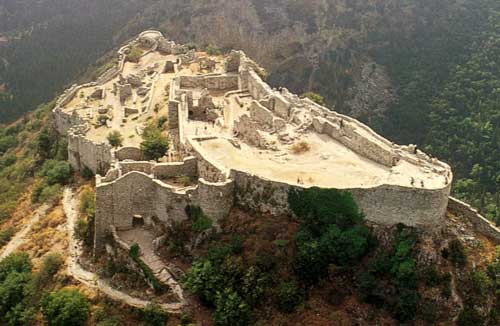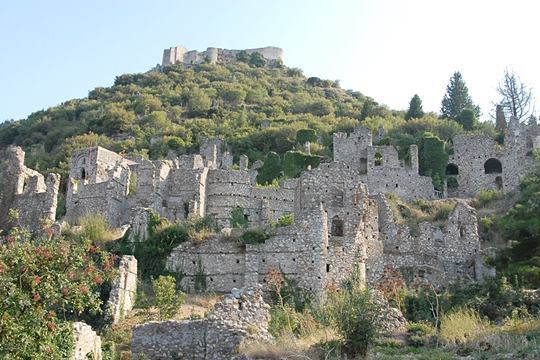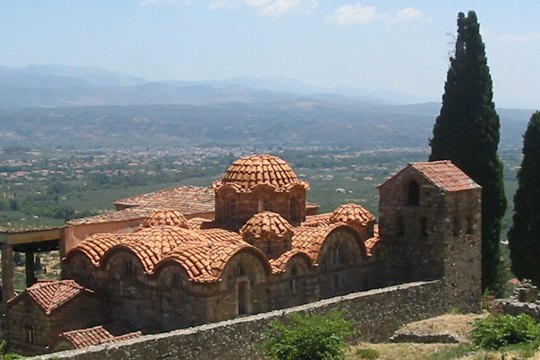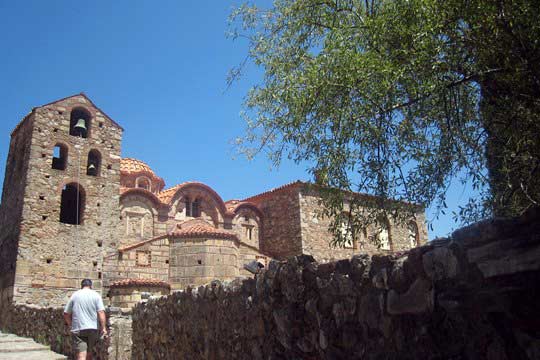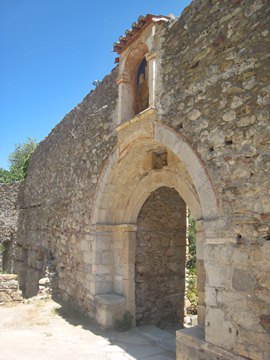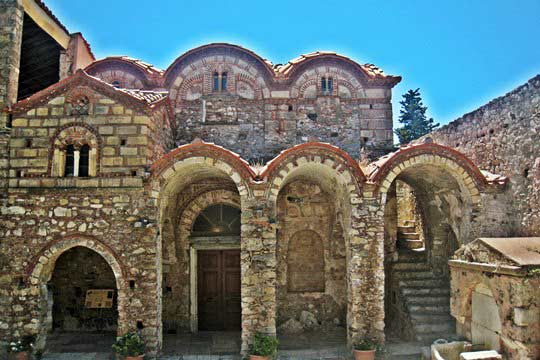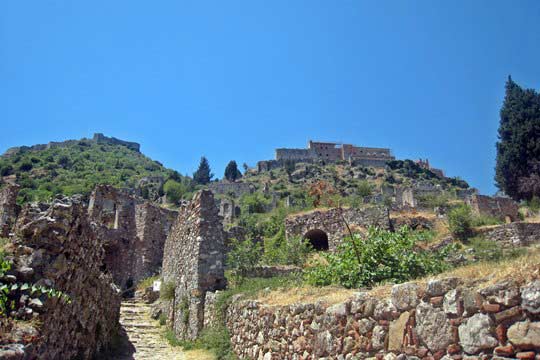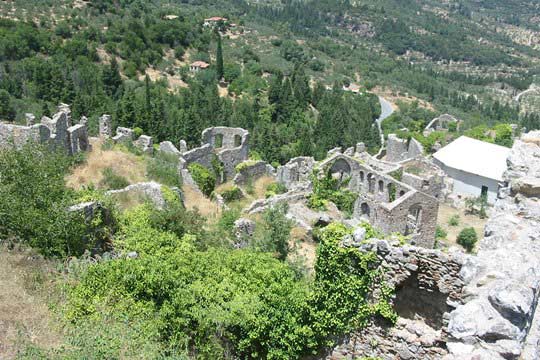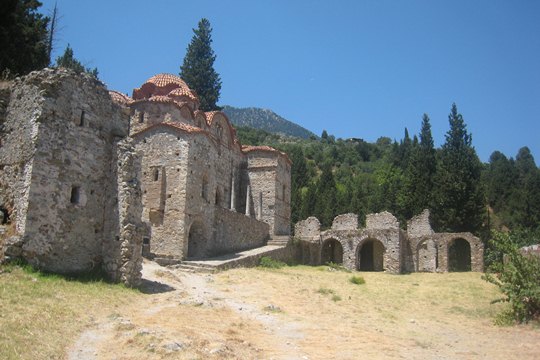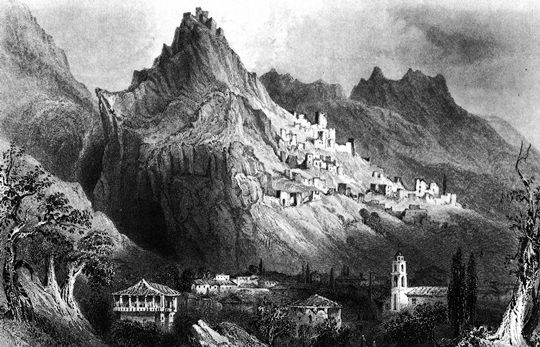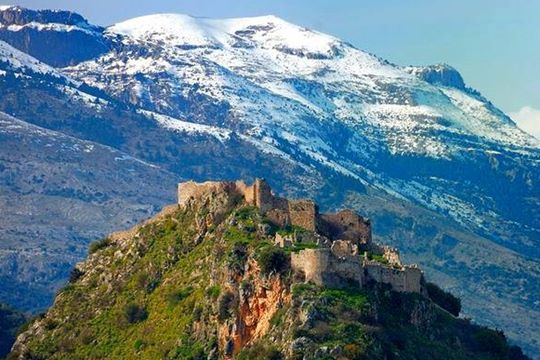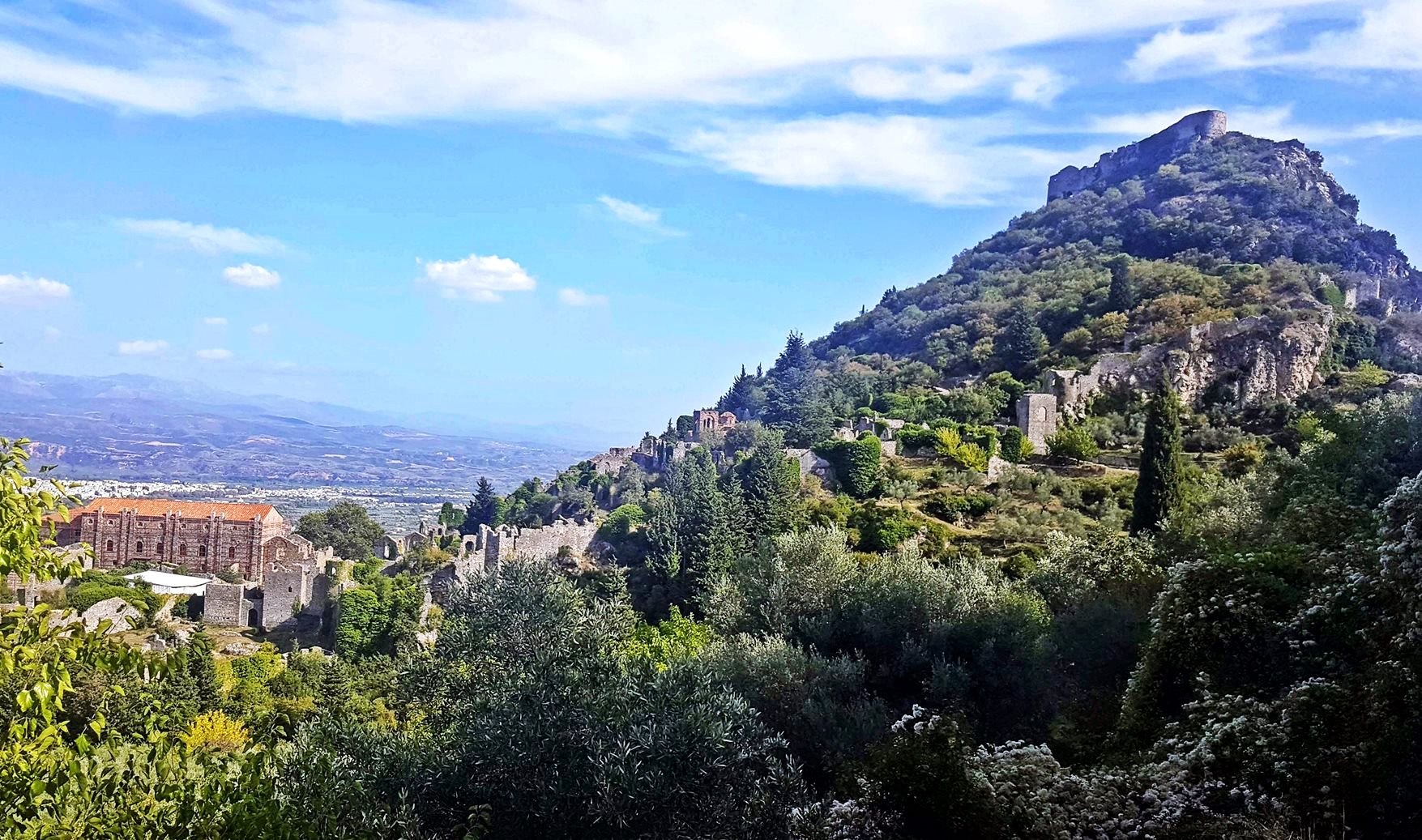Mystras, Sparta, Laconia,Peloponnese
Mystras
| Location: |
| Mystras, Sparta |
| Region > Prefecture: | 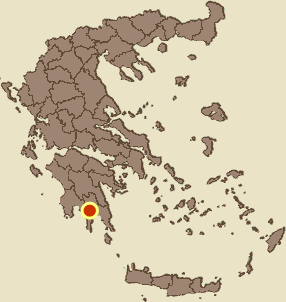 |
| Peloponnese Laconia | |
| Municipality > Town: | |
| City of Sparta • Mystras | |
| Altitude: | |
|
Elevation ≈ 280 m (Relative Height≈270 m) |
| Time of Construction | Origin | |
| 1249 | BYZANTINE |
|
| Castle Type | Condition | |
| Fortress-state |
Relatively Good
|
Mystras (Greek: Μυστράς) is a fortified town on Mt. Taygetos, west of ancient Sparta. It was built in 1249 by the Frankish Prince of Achaea William II of Vilehardouin. It served as the capital of the Byzantine Despotate of the Morea in the 14th and 15th centuries, experiencing a period of prosperity and cultural flowering. The site remained inhabited throughout the Ottoman period, when it was mistaken by Western travellers for ancient Sparta.
In the 1830s, it was abandoned and its population moved to the new town of Sparti.
Today Mystras is by far the most important Byzantine monument in Greece.
Location & Strategic Scope
The castle is on a steep hill that dominates the valley of Evrotas river, 6km west of the modern town of Sparta.
It is very possible that the decision of the Francs to build a castle there had to do with the vincinity to the ancient Sparta. For the Francs -far more than for the Byzantines- the possession of a castle was more than just a strategic choice. It was a demonstartion of power and success. Moreover, a castle in Sparta would be the ultimate status symbol. At a European level.
History
In 1249, Mystras became the seat of the Frankish Principality of Achaea, established in 1205 after the conquest of Constantinople during the Fourth Crusade, and Prince William II Villehardouin built a palace and a strong fortress here.
In 1262, the Latins ceded Mystras and other forts in the southeastern Peloponnese as ransom for William II, who had been captured in the Battle of Pelagonia. In 1289, during the reign of Michael VIII Palaeologos, the seat of the Byzantine region of Peloponnese was transferred from Monemvasia to Mystras.
In 1349 Mystras became the capital of the semi-independent Despotate of Moreas. The first Despot was Manouel Kantakouzenos (1349-1380), son of the Emperor John VI Kantakouzenos
A brilliant period began for the fortress-state. The hill was filled with houses, mansions, churches, fortified monasteries and palaces and the now densely-populated city was provided two enclosure walls.
In 1383 a new dynasty took over: the Paleologoi whose members were also emperors in Constantinople. The first despot of this era was Theodore A' Paleologos (1381-1407).
Mystras remained the capital of the despotate, ruled by relatives of the Byzantine emperor although the Venetians still controlled the coast and the islands. Mystras and the rest of Morea was prosperous compared to the rest of the empire. Under the despot Theodore it became the second most important city in the empire after Constantinople, and William II's palace became the second residence of the emperors. The main church of Brontochion Monastery was completed around 1310.
The last Byzantine emperor, Constantine XI Palaiologos, was Despot of Mystras before he came to the throne of Constantinople. Demetrius Palaeologus the last despot of Morea, surrendered the city to the Ottoman emperor Mehmed II in 1460. As Mezistre, it was the seat of a Turkish sanjak. The Venetians occupied it from 1687 to 1715, but otherwise the Ottomans held it until 1821. The city remained properous during all this time but a severe decline started after its destruction by Turkish troops in 1770 during the Orlof uprising.
During the Greek War of Independence, Mystras was again looted by the forces of Ibrahim pasha in 1825.
In 1834, the new Greek King Otto founded the new city of Sparta and the population moved gradually there. The place was abandoned. In 1921, Mystras was oficially declared an outstanding Byzantine monument. The last inhabitants were forced to leave in 1953.
Structure, Fortification & Buildings
There are 3 distinctive zones in the fortress: The Upper City (Ano Chora), the Lower City (Kato Chora) and the Outer City (Exo Chora). The 3 zones vary considerably in altitude and time of construction. In addition, there is the Frankish acropolis at the top, the first building on the rock.
In the upper city, there are the Despots’ Palaces, built on a level expanse of the hill. They were built between the 13th and 15th centuries and form a large complex dominated by the throne room.
In the lower city, the most prominent building is the Metropolis (church of Saint Dimitrios) with very interesting frescos. Here, the last Byzantine emperor, Constantine XI Paleologos was crowned in 1449.
Other interesting churches:
Monastery of Vrontochion founded by the abbot Pachomius. It includes the churches of Sain Theodoroi (1290-1295) and Hodegetria or «Afentiko» (1312-1322) which preserves high quality frescos.
Perivleptos, a church attached to a rock cave with very beautiful frescos.
Evangelistria, a small, elegant church with burial annexes.
Pantanassa, built in 1428 by the Protostrator (high Court official) Ioannis Frangopoulos, it is a magnificent synthesis and a result of various influences.
The Frankish castle at the top dominates the hill. It is accessible from the Upper City after a 20 min of uphill walking.
There is also an archaelogical museum in Mystras, housed in a building of 1754, with interesting pieces of Byzantine art.
Current Condition
A large part of the fortress-city is in ruins but the place is under constant maintenance. Many churches and the palaces have been restored.
Art & Logo
Mystras was the last centre of Byzantine scholarship; the Neoplatonist philosopher George Gemistos Plethon lived there until his death in 1452. He and other scholars based in Mystras influenced the Italian Renaissance, especially after he accompanied the emperor John VIII Palaiologos to Florence in 1439.
| First entry in Kastrologos: | April 2012 | Last update of info and text: | September 2020 | Last addition of photo/video: | September 2020 |
Sources
- Website Hellenic ministry of Culture-ΟΔΥΣΣΕΥΣ-Αρχαιολογικοί χώροι-Μυστράς
- Ιωάννης Θ. Σφηκόπουλος, Τα µεσαιωνικά κάστρα του Μορηά , Αθήνα,1968 — p.367-376
- Video by the user fab drone Mystras fortified town, drone
|
|
| Access |
|---|
| Approach to the monument: |
| Mystras is located 6km west of modern Sparta. |
| Entrance: |
| There are two points of entrance in the castle, in the Upper and the Lower city. Both accessible by car. There is a parking lot in both points. Ticket is required. |
| Timeline |
|---|
|



